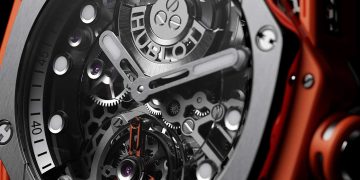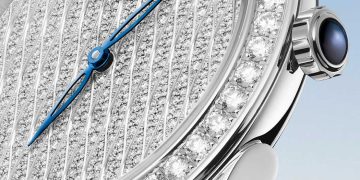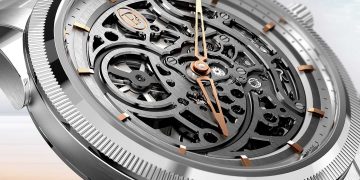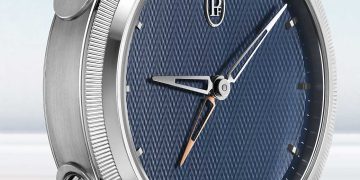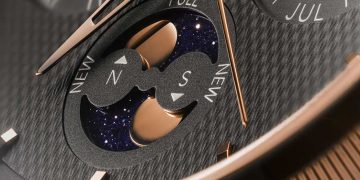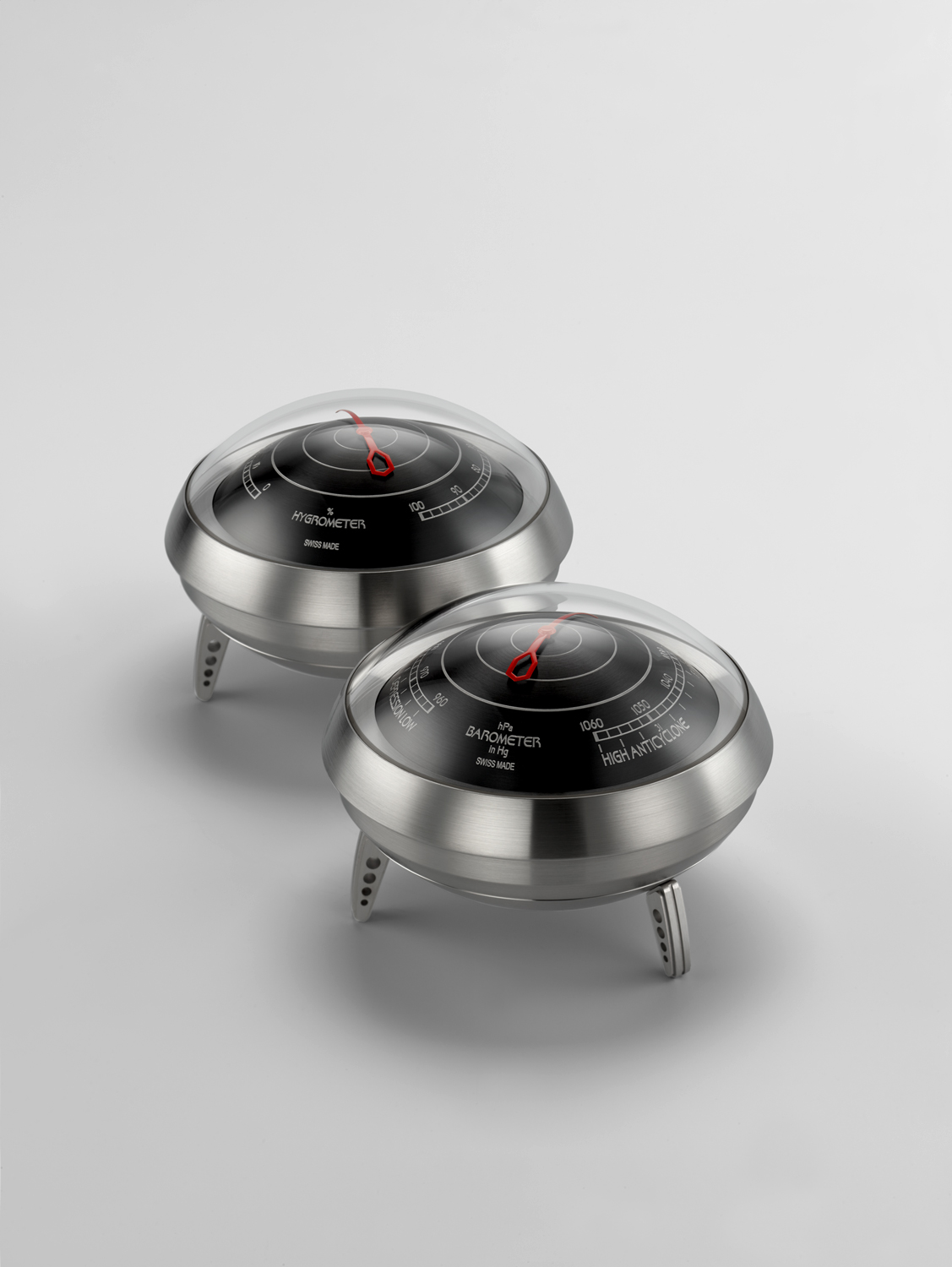
The Fifth Element is an intergalactic horological weather station enabling accurate weather forecasting even when the power goes down. Four (UFO) elements: clock, barometer, hygrometer, and thermometer combine in a mothership (with Ross, the alien pilot) to create an entity much larger than the sum of its parts: The Fifth Element.
An analogue weather station might at first glance appear anachronistic; however, when the storm hits and the power goes down, the Fifth Element will still work perfectly. And, in the worst-case scenario, you can hitch a ride off planet Earth with Ross.
MB&F founder Maximilian Büsser long admired desktop weather stations of the last century, but frustrated in not finding the right vintage model for himself decided to create his own.
Four removable and interchangeable instrument Elements make up the Fifth Element:
Clock Element
Because weather forecasting is based on the speed of changes over time, the accurate time is required for meteorological observations. For the Fifth Element, L’Epée 1839 reengineered and skeletonised their 8-day clock movement to maximize transparency and visual access.
Barometer Element
The barometer, which measures air pressure, is the mainstay of weather forecasting: as a general rule, increasing air pressure foretells good clear weather, decreasing air pressure portends inclement weather. The faster the change, the more extreme the coming weather.
Hygrometer Element
The hygrometer measures the percentage of water vapour in the air; it displays this as a percentage of the maximum amount of moisture that might be held at a given temperature.
Thermometer Element
Thermometers don’t simply measure temperature, but the average kinetic energy of a substance: the higher the temperature, the higher the energy. A thermometer is essentially a power reserve indication of the energy in the atmosphere around us.
While the Fifth Element attends to the serious side of weather forecasting with joyful fantasy, this space-age weather station was only made possible thanks to L’Epée 1839, which mastered the precision manufacturing of the intricate series of curves and circles within circles that make up the large structure. Over 500 individual components form the mother ship and its interchangeable Elements; more than many Grand Complications!
And there’s one more function that MB&F surreptitiously integrates into all of its machines: the ability to make you smile. For the Fifth Element, that role goes to Ross: thanks to his own manually-wound, air-regulated movement, the alien pilot rotates around the UFO’s cockpit checking that the skies are clear of both clouds and hostile invaders.
The Fifth Element is available in 3 limited editions of 18 pieces each in Black, Silver and Blue.
The Fifth Element in detail
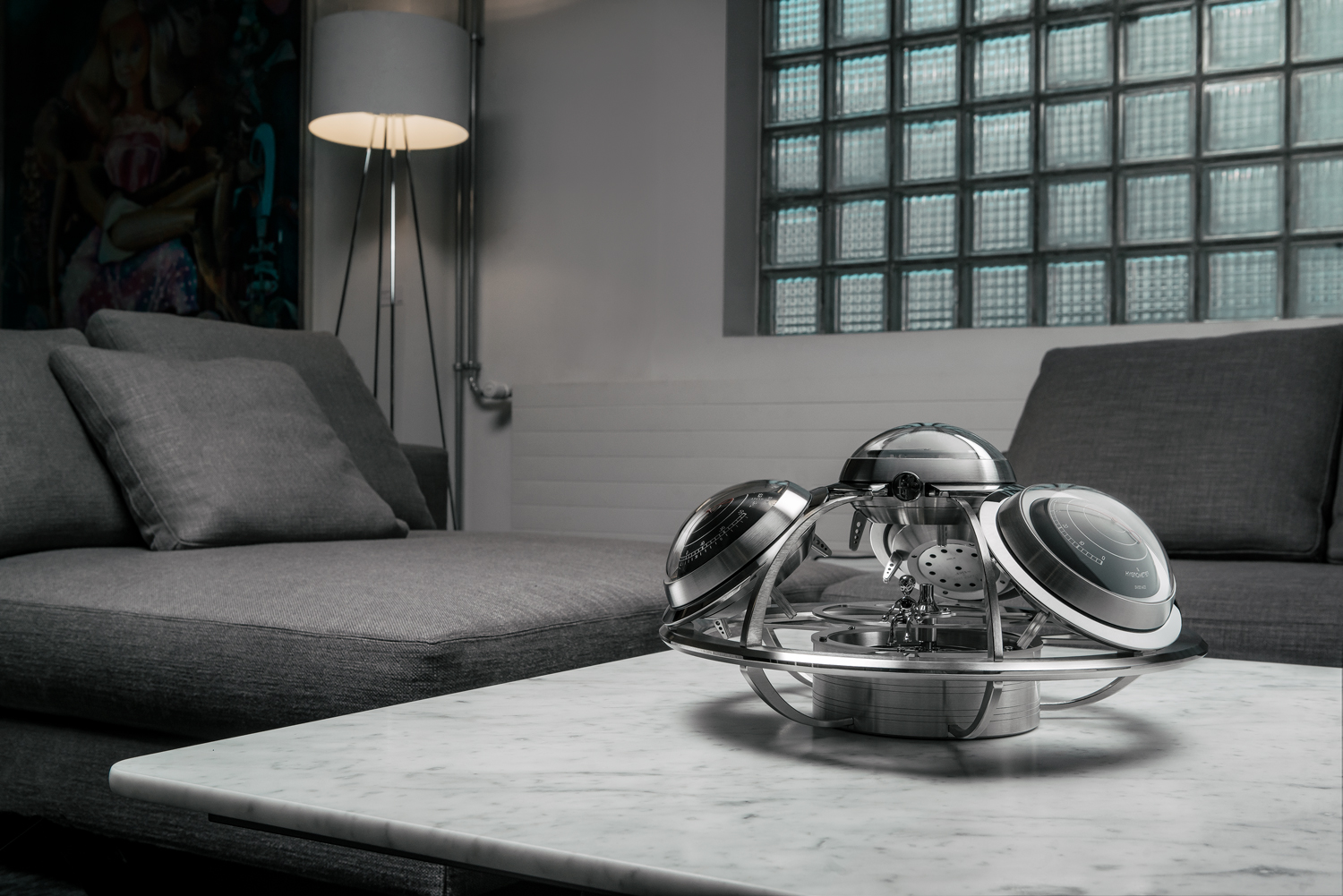
Inspiration and design
MB&F founder Maximilian Büsser had long looked for a beautiful vintage desktop weather station for himself, but could never find exactly what he was after; so with then intern-designer Stefano Panterotto he set about developing his own. The Fifth Element is a confluence of fantasies from classic UFO films, books, and comics of the 1950-60s with the desktop weather stations that were popular before weather forecasts were available on our phones.
The team researched weather stations across the last 100 years as well as the concepts of transparency, biomorphism, and both “inclusion” and “swarm” in animal/insect worlds.
While the Fifth Element was to be larger than its individual elements, each element had to be a strong standalone feature in itself: the team identified and came to understand each element, their stories, and how to feature them in a highly original way without concealing mechanical features.
After defining the four elements, the next step was the design of the Fifth Element, the hub in which the pods are housed. The challenge was to create an archetypical UFO of the 1950-60s, but without concealing any of the four elements.
Different structures and shapes were tried and tested, including a vertical configuration, before the final form was validated. Even then the process wasn’t finished as the first prototype looked a little too old-fashioned for MB&F, so it was tweaked yet again.
Realisation by L’Epée 1839
Once the design stage had been validated, the responsibility for making the Fifth Element a reality fell to L’Epée 1839, the only manufacture of high-end clocks in Switzerland.
The pieces making up the complex framework of curves and circles composing the structure of the Fifth Element had to be milled from solid blocks of brass in a process taking many hours. Even with all of that metal removed to make a visually light and open frame, you can feel the inherent solidity and quality in the construction.
Each of the four elements is composed of an outer case containing the core instrument of each module and can be placed on the Fifth Element structure. The clock had to be reengineered for a vertical escapement on the side for visual access.
The four elements – clock, barometer, hygrometer, and thermometer – are not only detachable and interchangeable; thanks to integrated support they can also stand, returning to the mothership when required.
In addition to the 8-day clock at the top of the Fifth Element, L’Epée created a second independent clockwork mechanism supported on bearings in the base and activated by a pushbutton. This starts Ross the alien pilot slowly rotating around the mothership as though constantly scanning the skies for both inclement weather and hostile invaders.
At the heart of the Fifth Element beats the clock movement, developed exclusively for this project by L’Epée, based on their superb in-house 8-day movement. The standard movement gear train is in-line i.e. all on the same plane; but for the Fifth Element, L’Epée rotated the regulator – consisting of the balance and escapement, the most complex mechanism in any clockwork regulator – a full 90 degrees to the movement. All this so the dynamic heartbeat could be fully appreciated from the side when docked into the mothership. Because the Clock Element is mobile (it can be detached from the Fifth Element and stand alone, as can all the Elements), the regulator features an Incabloc shock protection system to minimise the risk of damage when the Clock Element is being moved or relocated. While shock protection is standard in wristwatch movements, it is more unusual in generally immobile clocks.
The Clock Element movement features the same types of superlative fine finishing found on the finest wristwatches, including Geneva waves, bevelling, polishing, sandblasting, and circular and vertical satin finishing. However, finely finishing a clock movement is far more challenging than finishing a wristwatch because of the greater surface areas of the larger components.
While it’s usually the minuscule size of watch components that makes them so difficult to produce and hand finish with high precision, it was the opposite case for the Fifth Element in that its relatively large size diameter made manufacturing and decoration difficult. Hand polishing tiny watch parts is labour intensive but that pales in comparison with hand finishing the relatively massive surface areas on the components making up the Fifth Element. The rotating base brought its own challenges as it was already difficult to source ball bearings of the size and strength necessary to support the substantial weight, but finding bearings manufactured to the precision demanded by the project made it even more so.
The Fifth Element: Technical Specifications
The Fifth Element is available in 3 limited editions of 18 pieces each in Silver, Black, and Blue.
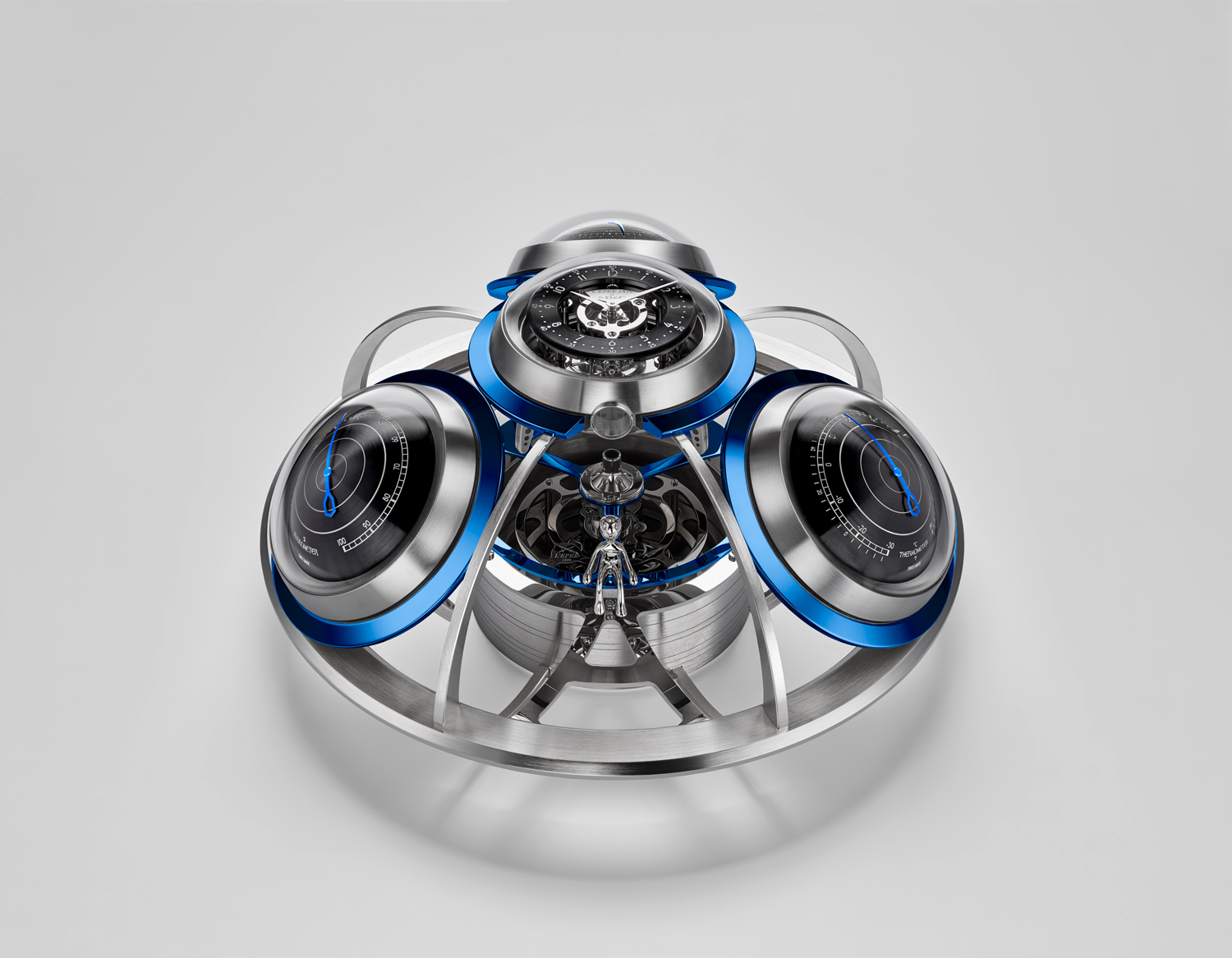
Indications/functions
Clock (hours and minutes), barometer (air pressure), thermometer (air temperature), hygrometer (air humidity)
Complete Fifth Element
Dimensions: 376 mm in diameter x 209 mm in height
No. of components: 531
Base clockwork: no escapement, minute repeater-type governor
Materials: stainless steel, brass, bronze (alien)
Total weight: 15 kg
UFO Clock Movement
L’Epée in-house designed and manufactured, vertical architecture eight-day movement
Dimensions: 124 mm in diameter x 92 mm in height
Balance frequency: 2.5 Hz (18,000 bph)
Power reserve: 8 days from single barrel in base
Components in movement: 161
Jewels: 11
Incabloc shock protection system
Movement finishing: polishing, bead-blasting, and satin finishing
Weight: 1,35kg
UFO Barometer
Atmospheric pressure: 960 / 1060 hPa (28.4 / 31.6 in Hg)
Dimensions: 124 mm in diameter x 92 mm in height
Dial: laser engraved
Display: curved hand
Components: 73
Calibration screw-in base
Weight: 1.80 kg
UFO Thermometer
Temperature: -30° / +70° Celsius (-20° / +156°Fahrenheit)
Dimensions: 124 mm in diameter x 92 mm in height
Dial: laser engraved
Display: curved hand
Components: 46
Weight: 1.90 kg
UFO Hygrometer
Hygrometer: 0 – 100% humidity
Dimensions: 124 mm in diameter x 92 mm in height
Dial: laser engraved
Display: curved hand
Components: 46
Weight: 1.90 kg
L’EPEE 1839 – the premier clock manufacture in Switzerland
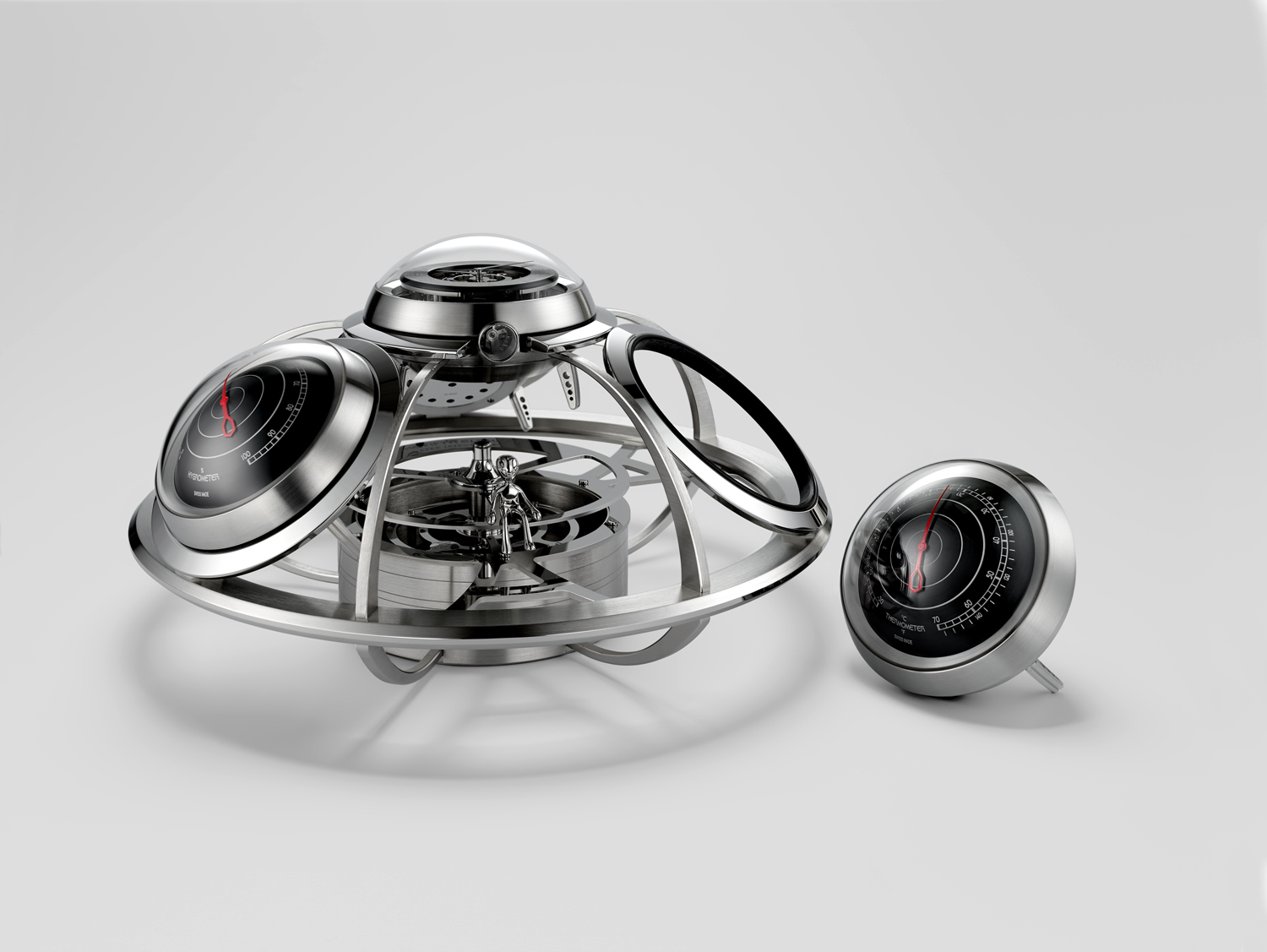
For more than 175 years, L’Epée has been at the forefront of clock making. Today, it is the unique specialised manufacture in Switzerland dedicated to making high-end clocks. L’Epée was founded in 1839, by Auguste L’Epée, who set up the business near Besançon, France to make music box and watch components.
From 1850 onward, the manufacture became a leading light in the production of ‘platform’ escapements, creating regulators especially for alarm clocks, table clocks and musical watches. By 1877, it was making 24,000 platform escapements annually. The manufacture became a well-known specialist owning a large number of patents on special escapements such as anti-knocking, auto-starting and constant-force escapements and the chief supplier of escapements to several celebrated watchmakers of the day. L’Epée has won a number of gold awards at international exhibitions.
During the twentieth century, L’Epée owed much of its reputation to its superlative carriage clocks and, for many, L’Epée was the clock of the influential and powerful; it was also the gift of choice by French government officials to elite guests. In 1976 when the Concorde supersonic aircraft entered commercial service, L’Epée wall clocks were chosen to furnish the cabins, providing passengers with visual feedback of the time. In 1994, L’Epée showed its thirst for a challenge when it built the world’s biggest clock with compensated pendulum, the Giant Regulator. At 2.2 m high, it weighs 1.2 tons – the mechanical movement alone weighs 120 kg – and required 2,800 man-hours of work.
L’Epée is now based in Delémont in the Swiss Jura Mountains. Under the guidance of CEO Arnaud Nicolas, L’Epée 1839 has developed an exceptional table clock collection, encompassing a range of sophisticated classic carriage clocks, contemporary design clocks and avant-garde horological sculptures. L’Epée clocks feature complications including retrograde seconds, power reserve indicators, perpetual calendars, tourbillons and striking mechanisms – all designed and manufactured in-house. Ultra-long power reserves have become a signature of the brand as well as superlative fine finishing.
MB&F – Genesis of a Concept Laboratory
In 2015, MB&F celebrated its 10th anniversary – and what a decade it was for the world’s first ever horological concept laboratory: 10 years of hyper-creativity; 11 remarkable calibres forming the base of the critically acclaimed Horological Machines and Legacy Machines for which MB&F has become renowned.
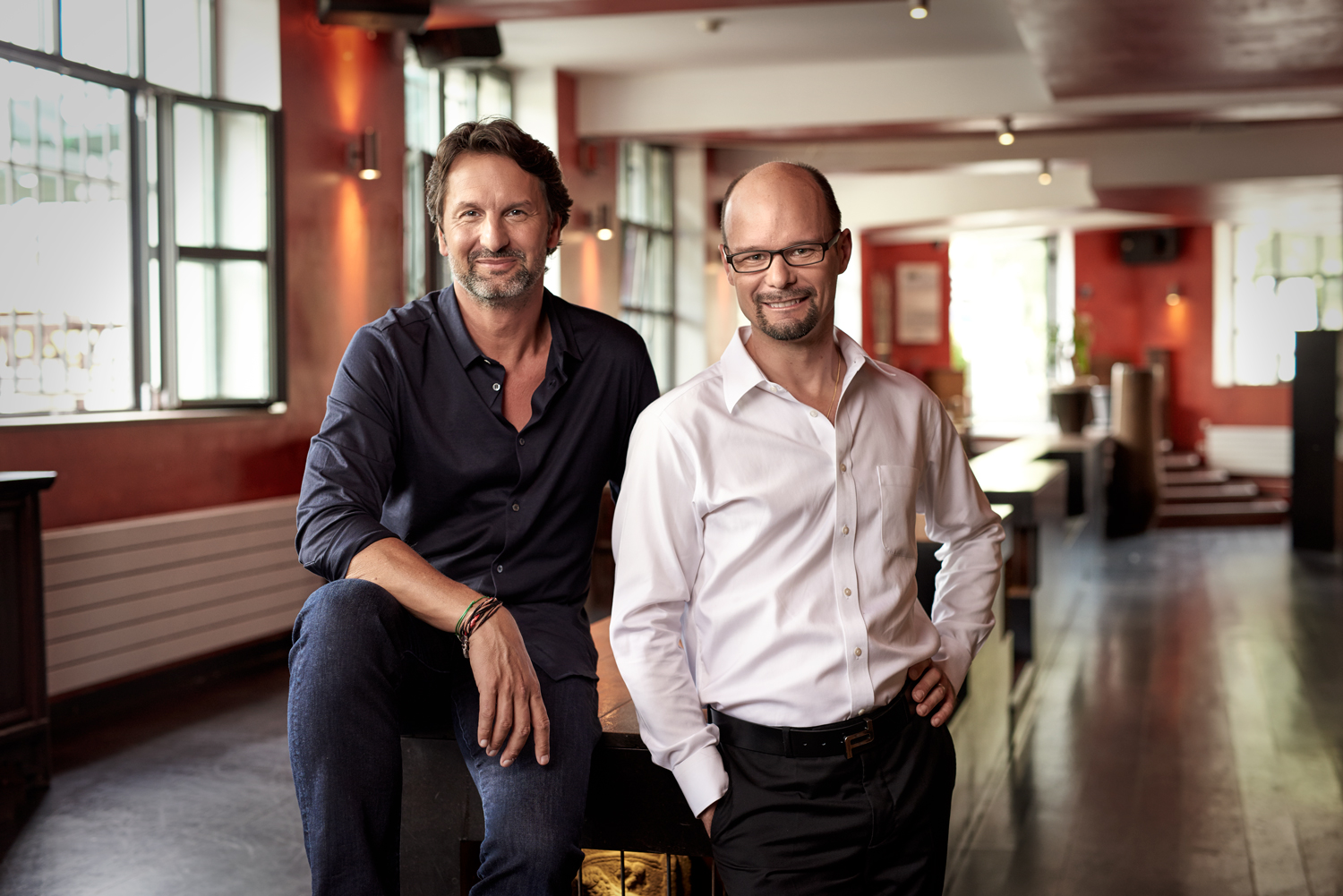
After 15 years managing prestigious watch brands, Maximilian Büsser resigned from his Managing Director position at Harry Winston in 2005 to create MB&F – Maximilian Büsser & Friends. MB&F is an artistic and micro-engineering laboratory dedicated to designing and crafting small series of radical concept watches by bringing together talented horological professionals that Büsser both respects and enjoys working with.
In 2007, MB&F unveiled its first Horological Machine, HM1. HM1’s sculptured, three-dimensional case and beautifully finished engine (movement) set the standard for the idiosyncratic Horological Machines that have followed: HM2, HM3, HM4, HM5, HM6, HM7, HM8 and HMX – all Machines that tell the time, rather than Machines to tell the time.
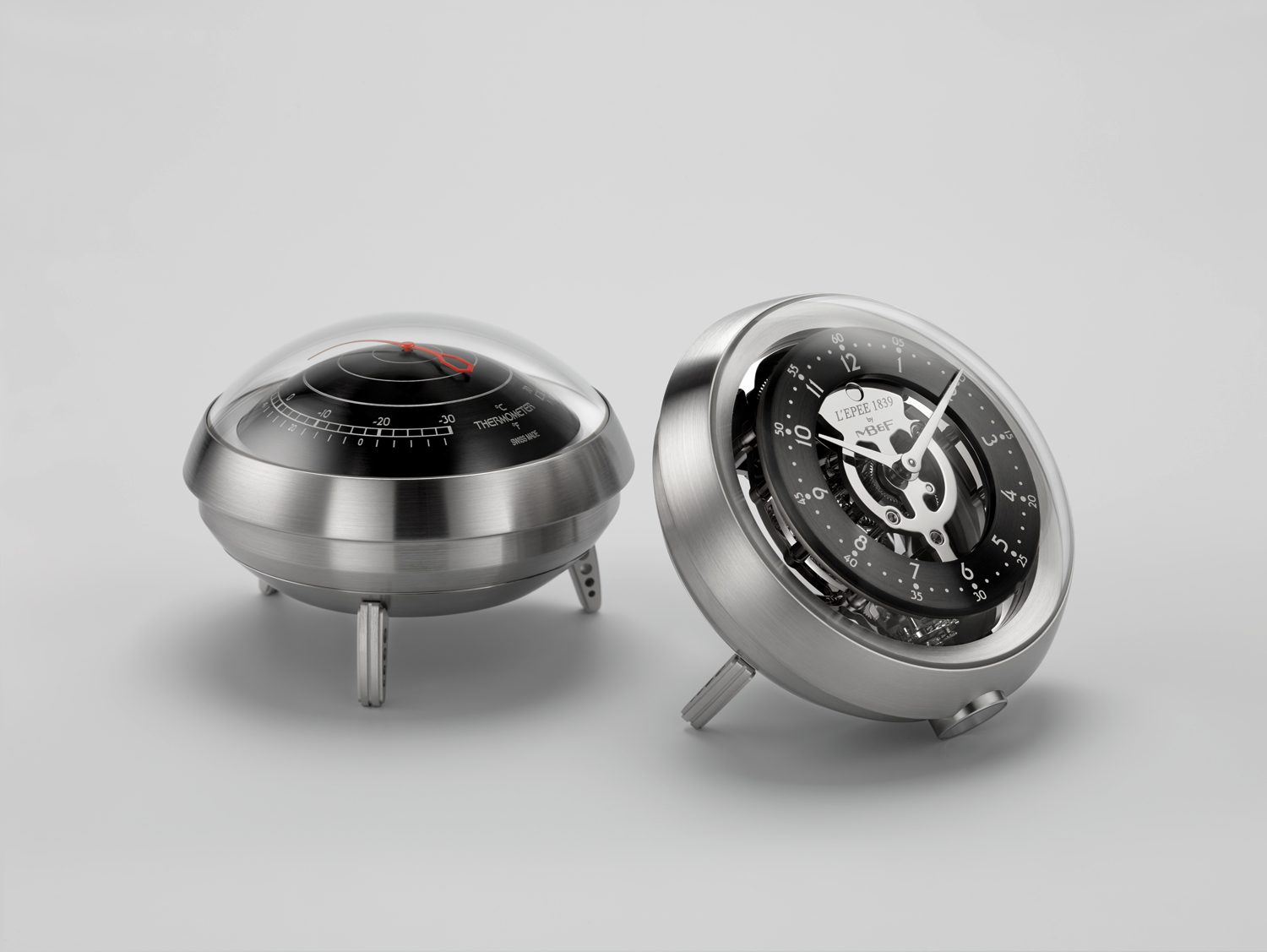
In 2011, MB&F launched its round-cased Legacy Machine collection. These more classical pieces – classical for MB&F, that is – pay tribute to nineteenth-century watchmaking excellence by reinterpreting complications from the great horological innovators of yesteryear to create contemporary objets d’art. LM1 and LM2 were followed by LM101, the first MB&F Machine to feature a movement developed entirely in-house. The year 2015 saw the launch of Legacy Machine Perpetual featuring a fully integrated perpetual calendar. LM SE was launched in 2017. MB&F generally alternates between launching contemporary, resolutely unconventional Horological Machines and historically inspired Legacy Machines.
As well as Horological and Legacy Machines, MB&F has created space-age MusicMachines (1, 2 and 3) in collaboration with music box specialist Reuge; and with L’Epée 1839, unusual clocks in the form of a space station (Starfleet Machine), a rocket (Destination Moon), a spider (Arachnophobia), an octopus (Octopod) and three robot clocks (Melchior, Sherman, and Balthazar). In 2016, MB&F and Caran d’Ache created a mechanical rocket-pen called Astrograph.
And there have been distinguished accolades reminding us of the innovative nature of MB&F’s journey so far. To name a few, there have been no less than 4 Grand Prix awards from the famous Grand Prix d’Horlogerie de Genève: in 2016, LM Perpetual won the Grand Prix for Best Calendar Watch; in 2012, Legacy Machine No.1 was awarded the Public Prize (voted for by horology fans) and the Best Men’s Watch Prize (voted for by the professional jury). In 2010, MB&F won Best Concept and Design Watch for the HM4 Thunderbolt. In 2015 MB&F received a Red Dot: Best of the Best award – the top prize at the international Red Dot Awards – for the HM6 Space Pirate.

